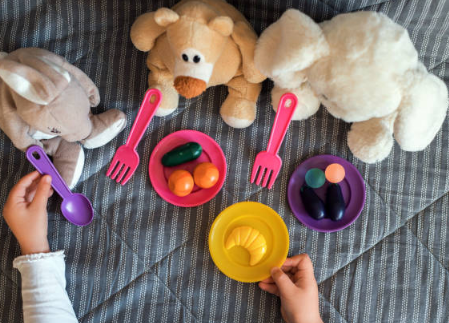Suction cups are filled with well-balanced food, easy-to-grip appliances are set up, and the most ergonomic high chair is in place. After two bites of rice and a finger dipped in applesauce, your child proudly declares, “It’s all done!” Oh no!
For parents, loss of appetite in young children can trigger a cascade of concerns. After all, making sure our kids have enough food is one of our most important jobs! Therefore, it is natural to question the child’s appetite. Are they full? Isn’t it too much? How can we get them to eat more?
But the truth is that it is completely normal for young children’s appetites to be unpredictable and fluctuate! So, take a deep breath and read on to learn how to decipher your child’s appetite and satisfy their fickle food needs.
Appetite in Young Children: What’s Normal?
Early childhood brings with it many new adventures… In the blink of an eye, your once-tiny baby goes from barely being able to slap a hanging toy to emptying every drawer in the bathroom. One minute they were drinking milk around the clock, the next they weren’t interested in eating. Therefore, it is normal for young children’s appetites to change as quickly as lightning, and one day they are full and the next day they barely reduce the amount of dinner.
Why Does My Child’s Appetite Fluctuate?
Many factors can affect a child’s appetite. Constipation, distraction, illness, and even sleepiness can cause them to eat less. Eating around other children or other family members may prompt them to eat more.
Young children grow at a slower rate than they did as infants, so they may not need the same nutrients as they used to. Often, parents will see an increase in appetite during a growth spurt, which is as normal as a decrease in appetite. In addition to the physical changes, your child is also changing developmentally, and they are becoming more aware of what they can control. Although they are still small, your little one is trying to assert a certain independence by denying your request for them to eat peas. Now that we’ve looked at the normal situation, how do we deal with these picky fluctuations?
Tips to Guide Your Toddler’s Appetite
Think beyond a meal
Rest assured, one meal is not a good reflection of your child’s overall eating habits Xi Think about what your child will eat over a period of days or weeks. Maybe they’re eating one day and gobbling it up a few seconds and a third the next! Keep in mind that if they don’t seem to be eating much at a meal or snack, they will soon have another chance to eat.
Toddler-friendly sections are available.
How much adults think toddlers should eat and how much they actually need to eat are often different! Imagine your child’s clenched little fist – it’s about the size of their stomach. That little belly could only hold so much food, and it filled up quickly, especially milk and juice. A good rule of thumb is to provide them with a tablespoon of each food for each age. For example, a 1-year-old will get 1 tablespoon of all the food groups offered, while a 2-year-old will get 2 tablespoons. Then, if they let you know they want more, you can add one more.
Be patient when introducing new foods.
From a developmental perspective, young children are more observant than ever of how food looks, feels, and tastes. If they’re skeptical of new foods, stay calm. It may take nearly 20 times for a toddler to accept new foods. To help your child accept new foods, small amounts of new foods can be offered, and if your child wants to, consider taking a bite together.
Consider the division of responsibilities
Ellyn Satter’s approach to feeding children is that everyone has a job at mealtimes. This perspective relieves some of the responsibilities of parents and asks children to take a more active role at mealtimes. A parent’s job is to provide nutritious food at a specific time and place, while a child’s job is to decide if and how much to eat. Give your child a variety of foods that provide the nutrients they need from whole grains, dairy, protein, fruits, vegetables, healthy fats, and legumes.
Give them a voice.
Toddlers want to make their own decisions, so let’s help them! While it is not developmentally appropriate to give young children free control over their own diet, it may be beneficial to let them choose between two foods so they can have a say in the matter. That way, even if the options are still somewhat limited, they will feel that everything is under control.
Encourage, but don’t pressure
Forcing your child to eat may affect their food experience, and they may not want to eat at all. Stay calm and trust that they will eat what they need.
Eat together as a family
Science supports the importance of a family diet. A 2018 review published in the journal Appetite found that family meals were associated with better nutritional intake, less irritability, and more enjoyment for infants and young children.
Know when to ask for help
If you’re concerned about your child’s appetite and eating Xi, don’t hesitate to consult a trusted pediatrician or dietitian.



